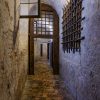The Bridge of Sighs. This corridor leads over the Bridge of Sighs, built in 1614 to link the Doge’s Palace to the structure intended to house the New Prisons. Enclosed and covered on all sides, the bridge contains two separate corridors that run next to each other. That which visitors use today linked the Prisons to the chambers of the Magistrato alle Leggi and the Quarantia Criminal; the other linked the prisons to the State Advocacy rooms and the Parlatorio. Both corridors are linked to the service staircase that leads from the ground floor cells of the Pozzi to the roof cells of the Piombi. The famous name of the bridge dates from the Romantic period and was supposed to refer to the sighs of prisoners who, passing from the courtroom to the cell in which they would serve their sentence, took a last look at freedom as they glimpsed the lagoon and San Giorgio through the small windows.
The New Prisons. Seat of all government and judiciary functions within the Republic, the Doge’s Palace also housed prisons. In the mid-16th century it was decided to build a new structure on the other side of the canal to the side of the palace which would house prisons and the chambers of the magistrates known as the Notte al Criminal. Ultimately linked to the palace by the Bridge of Sighs, the building was intended to improve the conditions for prisoners with larger and more light-filled and airy cells. However, certain sections of the new prisons fall short of this aim, particularly those laid out with passageways on all sides and those cells which give onto the inner courtyard of the building. In keeping with previous traditions, each cell was lined with overlapping planks of larch that were nailed in place.




